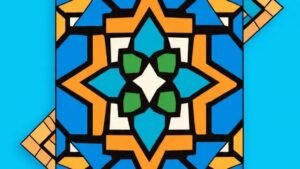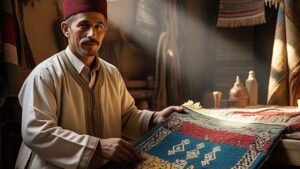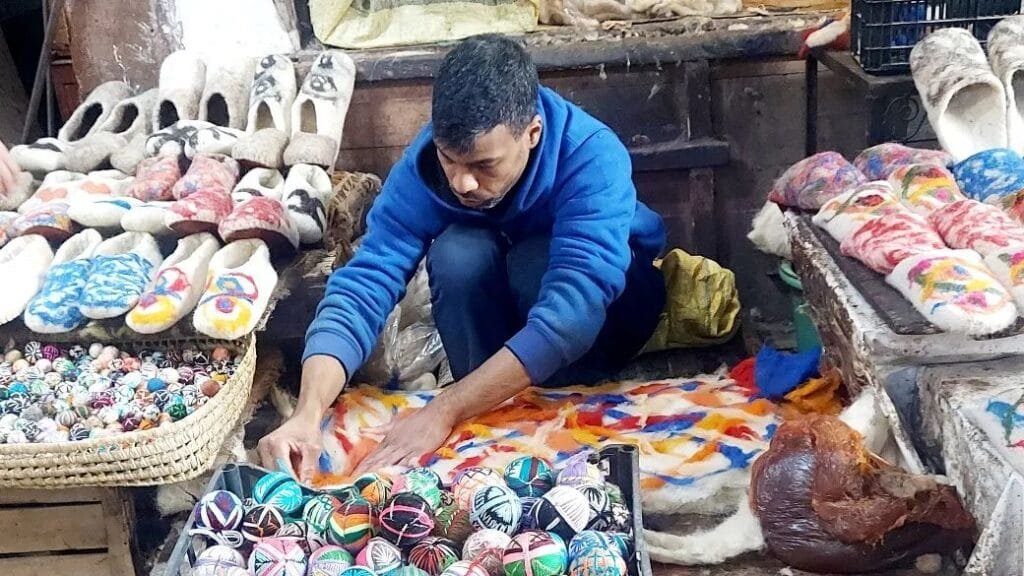
Walking through the old medina of Marrakech, you are struck by the beauty of everything around you—the vibrant colors, the intricate designs, and a man dedicated to keeping Moroccan wool felt craft alive. In his workshop, the air is filled with the scent of black soap and the sound of rhythmic movements as his hands press and knead the wool, folding the fibers into one another. Mohamed Masrour, moving with the same rhythm passed down through generations, shapes not just hats, slippers, or bags, but a living tradition—one that resists the tide of forgetting and keeps the heart of Moroccan craftsmanship beating strong.
Moroccan Wool Felt Craft: From Father to Son
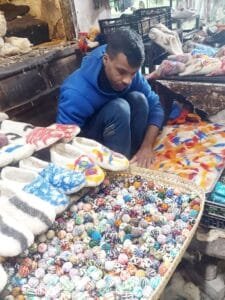
MoroccArtisans meet Mohamed Masrour in his small shop tucked inside Semmarine Souk, deep in the old medina of Marrakech. The scent of wool, black soap, and history lingers in the air. Bundles of raw, unprocessed wool rest in the corners, waiting to be transformed into exquisite examples of Moroccan wool felt craft. He sits on a worn wooden bench, his hands instinctively moving through the steps of his craft, as if guided by something older than memory itself.
At 41, Masrour has spent more than two decades perfecting Moroccan wool felt craft. He first held wool in his hands as a child, watching his father work late into the evening, the rhythm of kneading and rolling as familiar as his own heartbeat. “My father never told me to learn. He didn’t have to,” he says, pausing to press a fresh layer of wool into place. “I watched, and my hands memorized the steps before I even knew their names.” At 19, fresh out of high school, he made his decision—not to leave for university, but to stay, to continue what generations before him had built.
The process is both art and endurance. It begins with raw wool, carefully selected and cleaned. Layers are arranged, then dampened with warm water and mixed with thick black soap, the same kind Moroccans use in the hammam. Masrour kneads it, pressing firmly, folding and rolling in a precise, methodical manner. The fibers begin to bind, becoming something new—something strong, flexible, and enduring. “There is no rush,” he says. “The wool decides when it is ready. My hands only help it along.”
From Wool to Art: The Transformation Process
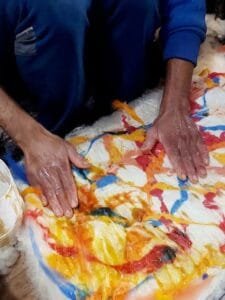
Unlike woven textiles, wool felt is born through pressure and time. It has no threads, no seams—just fibers merging, locking together in an irreversible transformation. This alchemy is what gives Moroccan wool felt its unique strength, making it both soft and nearly indestructible.
Masrour creates a variety of pieces, from hats with perfectly curved crowns to slippers that mold to the foot with wear. Each item takes up to four hours to complete, a process that cannot be rushed. “People think handmade means slow,” he says with a knowing smile. “But it’s not slowness—it’s care. Felt punishes impatience. If you try to force it, the fibers break. If you abandon it, it loosens. You must work with it, not against it.”
The shop is filled with finished pieces, each carrying the warmth of his hands. A deep crimson hat, reminiscent of the traditional tarboosh, rests beside a pair of soft gray slippers. A sturdy bag, its surface textured with tiny ripples from the pressing, holds the scent of wool and soap—a testament to the timeless artistry of Moroccan wool felt craft. “When you wear something made by hand,” Masrour says, holding up a newly finished slipper, “you are carrying a story. My story. My father’s. My grandfather’s. And now, it is yours.”
Moroccan Wool Felt Craft: A Disappearing Treasure
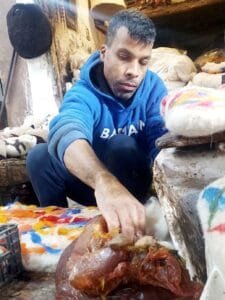
Once, the souks of Marrakech echoed with the sounds of wool being worked. In the 1960s, more than sixty workshops dedicated to Morocco wool felt craft filled the city’s markets. By the 1970s, that number had halved. Today, Masrour is among the last remaining artisans still practicing the craft, his hands preserving something that, without people like him, might vanish entirely.
He is aware of the challenge. “I am not the last,” he says, voice tinged with both pride and sorrow, “but we are few. Very few.” Young Moroccans rarely enter the trade, drawn instead to modern careers, digital work, and faster ways of earning a living. Felt-making requires patience, strength, and an acceptance of time’s slow rhythm—qualities that, in a world of machines, are no longer easily embraced.
Despite this, Masrour refuses to let go. He innovates, adapting the craft to new uses, experimenting with colors, and modernizing designs. “The old ways are beautiful,” he says, “but they must also find a place in the present. If we only look back, we will lose the future.” His products now appeal to tourists, designers, and those seeking authenticity in a world increasingly filled with imitation.
Wool in Morocco: A Timeless Heritage
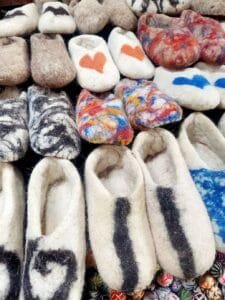
For centuries, Moroccan wool felt craft played a vital role in daily life. It padded saddles, softened the floors of nomadic tents, and covered the heads of men in the form of the iconic red tarboosh. It was warm in the winter, breathable in the summer, and naturally resistant to water—qualities that made it indispensable in a land of shifting climates.
Masrour understands this heritage deeply. “Felt was never just fabric,” he explains, smoothing a dampened sheet of wool beneath his hands. “It was protection. It was identity. It was a symbol of who we were.” He recalls stories his grandfather once told him—of palace officials donning felted hats, of horsemen covering their steeds in thick felted blankets before long journeys. “Today, people see it as something old-fashioned,” he sighs. “But they forget—it was once the mark of elegance, of power, of necessity.”
Though modern materials have replaced wool felt in many aspects of Moroccan life, its spirit endures. Masrour sees it in the tourists who run their fingers over his handmade goods, in the collectors who seek out his work. “They don’t always know the history,” he says, “but they feel it. They know, in some way, that this is something real.”
Moroccan Wool Felt Craft: Hands Shaping Tradition
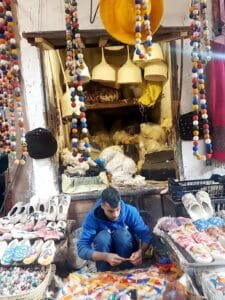
Moroccan wool felt craft was once a necessity, not a luxury. It lined saddles, softened prayer rugs, and crowned the heads of palace guards. It was waterproof, durable, and nearly eternal—a textile that did not fray, did not tear, did not surrender to time.
Masrour understands this history, and while he embraces tradition, he refuses to let it become stagnant. His hands shape felt not just for nostalgia, but for life today. His slippers are no longer just for the home; they are for the street. His bags are not simply rustic; they are stylish. His hats are not only echoes of the past; they are statements of the present.
Yet even with these changes, the essence remains untouched. The wool still comes from the Atlas Mountains. The soap is still thick and black. The method is still slow, deliberate, and deeply human. “People forget that felt is alive,” Masrour says, pressing a fresh piece between his palms. “It breathes. It listens. And if you treat it well, it lasts forever.”

